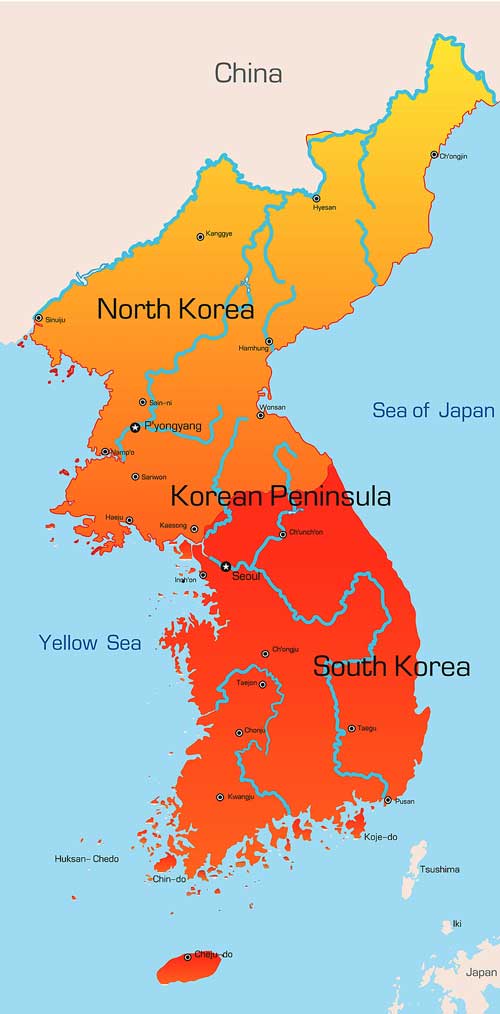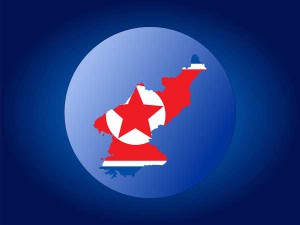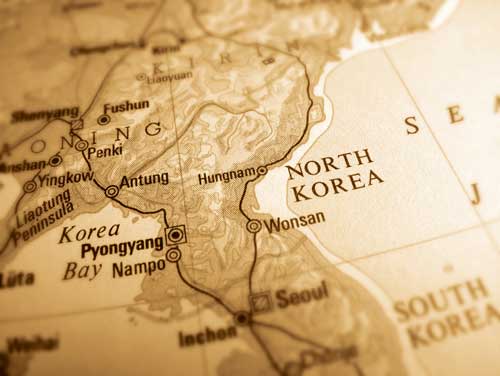08/03/2011 – The London-based International Institute for Strategic Studies (IISS) recently released an insightful new report on the security challenges presented by the Democratic People’s Republic of Korea (DPRK) to the international community. Its latest Strategic Dossier, “North Korean Security Challenges: A Net Assessment,” offers a comprehensive and balanced evaluation of the topic. The 200+ page monograph reviews the domestic situation in North Korea, the foreign and military threats the DPRK presents to the Republic of Korea (ROK) and other countries, and the possible scenarios that might lead to the regime’s collapse and possible reunification with South Korea. The team of authors, led by editor Mark Fitzpatrick, director of the IISS Non-Proliferation and Disarmament Programme and a former senior U.S. State Department official, did a nice job helping the reader understand the complex, multi-dimensional nature of the North Korean problem.
According to the IISS team, the DPRK currently presents several major international security challenges. The most well-known DPRK defense capacity is North Korea’s illegal nuclear weapons program, pursued in violation of the country’s treaty obligations and other nonproliferation commitments. For two decades, North Korea has been diverting plutonium from its nuclear reactor complex at Yongbyang to make fissile material to fuel a nuclear explosion. In 2006 and 2009, the DPRK detonated one nuclear explosive device. The IISS estimates that the DPRK currently has sufficient plutonium to make 4–12 additional nuclear bombs.
More recently, the DPRK has launched a new uranium enrichment program that can also manufacture fissile material for a nuclear weapon. The authors expect that North Korea’s future nuclear weapons activities will focus on employing this enrichment program since, while Yongbyang could be reopened in approximately six months, uranium enrichment activities are easier to conceal than a plutonium-based nuclear weapons programs.
In addition to its nuclear weapons program, the IISS assesses that North Korea has the world’s third largest chemical weapons arsenal and possibly biological weapons. It is fairly easy for well-disciplined and equipped troops, like those of the ROK and the United States, to defend against chemical weapons. But civilians are harder to protect unless they are warned in advance of an impending chemical weapons attack. The current IISS team has less confidence than the writers of the previous DPRK dossier that North Korea is continuing to pursue a comprehensive offensive biological weapons program. And biological weapons are more difficult to employ.
The DPRK produces large numbers of ballistic missiles. North Korea uses them to enhance its own strike capabilities, compensating for its weak air force, as well as to sell to foreign buyers. The DPRK has developed several ballistic missiles types, of varying ranges and capabilities, which may be able to deliver WMD munitions to targets in South Korea and Japan. Under the guise of developing a space launch vehicle, the DPRK is working on an intercontinental-range missile capable of hitting targets as far as California and Alaska. The IISS analysts have major questions about the capabilities of the DPRK’s new missiles since some on public display look like mock ups.
In one of several controversial findings, the IISS analysts argue that the DPRK’s missile program may prove vulnerable to a supply cut-off. They believe that North Korean technicians have largely been relying on parts and technologies acquired from the Soviet Union, including legacy engines and other key components, to assemble missiles based on earlier Soviet-era designs. They see no evidence that Russian companies are supplying more missile parts or additional technologies to the DPRK, while the believe that North Korean technicians will require a few more years to be able to make such core components themselves.
Other analysts believe the DPRK has already learned how to manufacture its own ballistic missiles and is moving beyond simple knock-offs of Soviet-origin designs.
The current focus of the DPRK’s WMD-related research and development efforts focus on making warheads sufficiently small and secure that they can carry nuclear or other dangerous agents on North Korea’s improving ballistic missile capacities. The DPRK has yet to demonstrate that it has manufactured a warhead that can fly long distances safely atop a ballistic missile, but the IISS team considers such a task not especially difficult.
They are more uncertain how long it will take the DPRK to do this. It depends on whether North Korea has been able to obtain one of the designs for tested warheads that the A. Q. Khan illicit trafficking network was selling on the black market, which would accelerate its progress.
There is little indication that the DPRK leadership has developed a doctrine for actually employing its nuclear weapons in combat. Rather, the IISS analysts believe that North Korean leaders view nuclear weapons as a means of elevating their prestige and legitimacy at home as well as the DPRK’s influence and status in the international arena.
A more immediate danger, evident for some time, is how North Korea has been contributing to the horizontal proliferation of nuclear, ballistic missile, and other dangerous technologies to regimes of proliferation concern. The fear is that, for financial profit or barter, the DPRK would transfer WMD-related technologies to other rogue states or terrorists.
This problem has already occurred; there is considerable evidence that the DPRK has assisted Syria, Libya, and other countries to develop WMD-related technologies and their means of delivery. Interestingly, the IISS team finds little indication of uranium enrichment cooperation between North Korea and Iran. Both countries use different centrifuge models. In addition, North Korea is capable of manufacturing high-strength steel that Iran has been unable to acquire, forcing Tehran to rely on carbon fiber materials that are less reliable.
The DPRK Korean People’s Army is the world’s fourth largest; but the IISS net assessment finds that the DPRK’s conventional military capabilities have fallen even further behind those of the ROK. In any conflict, South Korea would also enjoy the military support of the United States under their longstanding mutual defense security pact. This pact includes an extended security guarantee that could see the United States use nuclear weapons to protect the ROK. In any full-scale war between the two Koreas, the ROK should eventually win.
 A Unified Korea in the Works? (Credit: Bigstock)
A Unified Korea in the Works? (Credit: Bigstock)
Nonetheless, that “eventually” is a key word—the North could inflict considerable damage against the South before its defeat. The one welcome finding of the IISS team is that North Korea’s long-range artillery is unlikely to turn Seoul into a “sea of fire” since, by their calculations, the DPRK has only some 300 such guns and will likely need to pull them back into defensive positions soon after hostilities commence or they will be destroyed by ROK and U.S. counter-battery fire.
However, last year’s DPRK sinking of the ROK Cheonan warship and its shelling of civilians on the Yeonpyong Island demonstrates that the DPRK is willing to use even limited conventional capabilities in provocative ways. The latter incident represented the first direct attack on ROK territory by the DPRK regular military since the 1950-53 Korean War, but both incidents occurred in areas overlapping the contested boundaries of the two states, and were not followed by subsequent DPRK attacks. Both conditions kept the level of fighting below the threshold of major war.
Although the superior conventional and nuclear capabilities of the ROK-U.S. alliance can credibly deter DPRK conventional attacks, they are much less effective at deterring lower-level provocations, which the DPRK has been conducting for decades even if the 2010 incidents marked a major escalation from previous years. Although its quantity of conventional weapons is enormous, it is North Korea’s willingness to use them that makes the country such a serious menace.
The DPRK is also developing asymmetric capabilities and tactics to compensate for its conventional weaknesses. These include the weapons of mass destruction listed above, special forces that can enter ROK territory through underground tunnels as well as on midget submarines, cyber weapons that make the information-dependent and highly networked South Koreans feel vulnerable, and the use of military force short of a full-scale confrontation.
North Korea has the largest number of special forces anywhere in the world, though the IISS contests the ROK government’s assessment that the DPRK has 200,000 of these personnel. According to the IISS, while some 200,000 DPRK troops have undergone specialized training, perhaps only 80,000 of these troops are equivalent to the U.S. or British Special Forces, trained in a comprehensive range of light warfare and clandestine strike missions.

The DPRK’s economic problems, though grave, are insufficient to hurt the country’s military capabilities since the regime is sufficiently inured to popular suffering that it can devote almost a fourth of the country’s GDP to its defense sector. Changes are occurring in North Korean society. The public food distribution system collapsed in the mid-1990s, private markets grew to replace it and have not been repressed for long, and people have gained increased knowledge of the outside world through radios and other news sources.
Furthermore, income rather than political standards are becoming the most important determinant of the DPRK’s class structure since income disparities are increasing as North Koreans become more involved in market activities.
Even so, while the direction of domestic change in the DPRK is clearly toward modest fragmentation and liberalization, the magnitude and pace of this change should not be overestimated. North Korea remains the world’s most militarized country in which the military-industry complex receives priority in terms of resource allocations and in which domestic opposition, dissent, and even the wrong thoughts are severely repressed by the police and military.
Among other things, these conditions have led to a surging number of refugees fleeing into China and settling into South Korea. The DPRK’s “military first” (songun) policy has resulted in North Korean generals exercising as much influence as leaders of the ruling Workers’ Party of Korea (WPK), which has had to share power collectively with the military as well as the Kim dynasty.
Despite its police state nature, the IISS concludes that “criminality” is “hard-wired into the regime.” The DPRK has engaged in diverse forms of state-sponsored crime including the kidnapping of foreign nationals (the Japanese abductees are best known since Tokyo raises them as a barrier to further engagement with the DPRK); trafficking in narcotics, people, and many other forms of contraband; and the counterfeiting of foreign currency (especially well-crafted $100 bills).
The IISS report makes evident that the DPRK is clearly a menace to its people, neighbors, and much of the rest of the international community. Its hyper-militarism, economic mismanagement, and inability to implement major economic reforms due to fear of undermining the political dictatorship have made the DPRK dependent on foreign assistance.
The DPRK has in the past managed to blackmail the United States, South Korea, and Japan with threats of conducting more provocations while offering (and then reneging on) pledges of good behavior in return for sufficient compensation. But the DPRK’s previous partners are unwilling to buy that same horse yet again. The IISS concludes, like others, that the DPRK is unlikely to relinquish its nuclear weapons arsenal in return for exclusively economic and diplomatic aides.
Even so, the process of dynastic succession is now proceeding in Pyongyang in circumstances much less favorable than during the first dynastic transfer after the death in 1994 of Kim Il-sung, the regime’s god-like founder. Although Kim Il-sung died suddenly, he had prepared his son for years to succeed him. In contrast, Kim Jong-il’s health abruptly deteriorated before he had designated a successor and prepared him to fulfill that function.
Although Kim Jong-Il seems to have recovered from his 2008 stroke, he has been pushing to establish favorable conditions for his third son, Kim Jong-un, to succeed him. If his father dies soon, Kim Jong-un will experience severe disadvantages due to his limited experience, fragile power base, political barriers to needed economic reforms, and the military’s elevated role in politics (Kim Jong-un’s recent promotion to general may have hurt rather than helped his standing with other military leaders).
The troubled conditions surrounding the political succession could spell trouble for others since the regime’s increasingly provocative behavior might be designed to rally support behind the Kim dynasty.
Although warning that expectations regarding the demise of the DPRK regime have been both frequent and incorrect, the IISS analysts nevertheless believe that the circumstances may be conducive now for major changes. The regime is experiencing an unprecedented conjunction of crises of which four interlinked problems are most serious.
1) First, the IISS teams notes that political succession is always “the Achilles’ heel of dictatorships,” especially one that adheres to the principle of dynastic political inheritance in a nominally Marxist-Leninist state.
2) Second, North Korea’s economic problems have become very serious due to its progressive loss of many vital sources of foreign aid, an inability to abandon economically harmful but politically stabilizing policies, widening income disparities, and perennial food and health care shortages that threaten to degrade North Koreans’ human capabilities. The result of all these economic problems is an impoverished and increasingly disenchanted population as well as hordes of refugees fleeing to neighboring countries.
3) Third, the DPRK’s long-standing policy of brinkmanship no longer yields major concessions; they do however increasingly risk provoking a major war. Pyongyang’s outrageous provocations against the ROK last year—sinking the Cheonan and shelling civilians on a border island—have so antagonized South Korean public opinion that vigorous retaliation to any further provocations has become much more likely since President Lee Myung-bak would find it difficult not to strike back. ROK military doctrine now emphasizes the need for a prompt and vigorous response to future DPRK provocations.
4) All these problems have created a fourth, existential, crisis in which North Koreans have increasingly lost faith in their regime even if they lack the means to depose it. The incongruence between the DPRK regime’s proclaimed successes and its genuine failures will become increasingly evident in 2012 due to its pledge to create a “strong and prosperous nation” that year, the centennial of the founding father’s birth. The recent upheavals in the Arab world are a welcome reminder that even the most long-lasting dictatorships cannot last forever.

The IISS analysts see several possible routes to unification. The best outcome would be a “soft landing” in which the weight of the DPRK’s problems gradually saps its strength and North Korea no longer threatens other countries. At some point, this process could lead to intra-Korean reconciliation and the gradual integration of the two Koreas.
Unfortunately, fundamental change is not visible on the horizon, while even a more mellow DPRK would have good reasons to keep its nuclear weapons, especially if the regime’s other support props no longer work. The IISS also considers a German-style reunification through absorption, along with the DPRK’s regime voluntary collapse, extremely unlikely due to its ingrained militancy.
According to their assessment, a violent and abrupt collapse represents a more plausible scenario. This process could occur due to a major internal challenge, perhaps from a dissatisfied General or popular uprising, or from a confrontation with South Korea that escalates out of control. For example, the DPR leadership might take a provocative action assuming that its nuclear deterrent would avert military retaliation, only to be proved wrong about its presumed “escalation dominance.”
North Korea’s possession of nuclear weapons could present real problems here—as it does with the fourth “nightmare” scenario, reunification through war, in which the ROK would intervene to occupy North Korea. This scenario also runs the high risk of Chinese military intervention to preserve a sphere of influence. The authors call on the ROK, PRC, and U.S. governments to discuss this possible scenario beforehand to minimize misunderstandings. But I have tried this myself in Beijing. The Chinese keep quiet for fear of irritating the DPRK’s erratic leadership, which object to anyone even mentioning its possible demise.
Another consideration has been that Chinese leaders have, after several years of reassessing their Korean polices, resolved to prevent the Kim regime’s collapse no matter how much they dislike it. According to the IISS, the PRC government appears to have made a strategic decision that a unified Korea under Seoul’s leadership and allied to the United States threatens its fundamental interests.
Since mid-2010, the PRC has increased its assistance to the DPRK, including by providing more diplomatic support and economic aide.
Yet, the authors believe that Beijing’s help might prove sufficient to help the DPRK avoid the collapse and unification scenarios, but at the risk of China’s extending its hold so tightly over the DPRK that North Korea becomes an economic satellite of Beijing that still retains considerable capabilities and inclination to cause trouble on its own.
***


